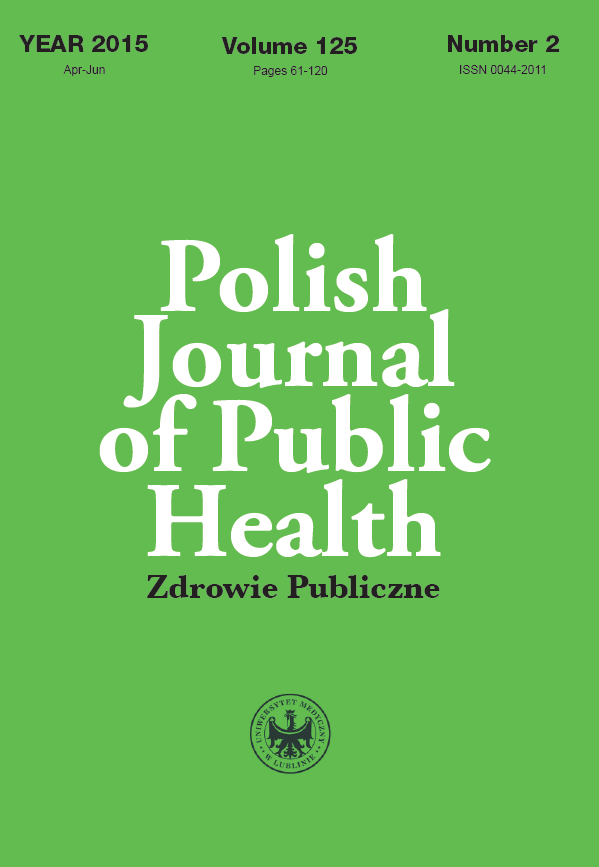Examining the image of nursing among the children hospitalized in the oncology ward
DOI:
https://doi.org/10.1515/pjph-2015-0031Keywords:
children, nurses, opinions, professional image of a nurseAbstract
Introduction. Patients, as subjects of medical care, are becoming increasingly more demanding toward medical professionals which poses a challenge both for doctors and nurses. A variety of factors influences the professional image of a nurse. Different features are involved, including the nurse’s professional or interpersonal skills their personal beliefs, attitude, as well as social stereotypes about nurses.
Aim. Looking at the image of nursing among the children hospitalized in the oncology ward.
Material and methods. The authors used both literature review and a questionnaire of their own making. The literature review was done using data from the databases of Polish Central Medical Library. The research group comprised 32 children (aged from 8 to 17), all undergoing hospitalization in Hematology/Oncology and Child Transplantology in Lublin. The statistical calculations are made using Chi2 tests. The test results of p<0.05 were held as statistically significant.
Results. The group was mostly composed of children aged 14 to 17 (56.25%). There were more boys (62.5%) than girls. The majority of children came from rural areas (71.87%) and most of them read through the documentation concerning the rules of the ward. Both nurses’ work and relations with patients were graded as “good” by the patients. Children pointed to “nice appearance” as the most important feature of every nurse.
Discussion. A pediatric nurse should be patient, have lots of understanding, be sympathetic, caring and able to hold their nerve. Unfortunately, according to authors of earlier studies, not all nurses have these traits. This is due to the fact that the staff rarely involve in communication with the patients and they lack interpersonal skills.
Conclusions. Children have a very high opinion on the work of nurses at the Hematology/Oncology and Child Transplantology Clinics. The children emphasized that the following features have the highest impact on their picture of the nurse: nice looks, being protective and caring. A research study conducted at the Hematology/Oncology and Child Transplantology Clinics shows the right features that a nurse should have.
References
1. Obuchowska I. Pielęgniarka a chore dziecko. In: B. Pawlaczyk (ed). Pielęgniarstwo pediatryczne. Podręcznik dla studentów medycznych. Warszawa: PZWL; 2007. p. 23-6.
2. Koper A, Wrońska I (ed). Problemy pielęgnacyjne pacjenta z chorobą nowotworową. Lublin: Czelej; 2003.
3. Wysocki M, Czerwonka-Szeflarska M.:Pediatria i pielęgniarstwo pedi¬atryczne-dziecko w zdrowiu i chorobie. Wybane zagadnienia. Bydgo¬szcz: Akademia Medyczna im. Ludwika Rydygiera; 2004.
4. Marć M. Komunikowanie jako element opieki pielęgniarskiej nad dzieckiem i rodzicami w oddziale szpitalnym. Materiały konferencyjne. Standaryzacja opieki zdrowotnej (25-27 kwietnia 2001 r.). Kraków; 2001. p. 193-7.
5. Kuna J, Tymecka I. Czynniki wpływające na pełnienie roli ekspresyjnej przez pielęgniarkę pediatryczną. Prob Szkol Nauk. 1983;3-4:41-5.
6. Mee C. Painting a portrait: how you canshape nursing¢ s image. Imprint.2006;53(5):44-9.
7. [htpp://www.gallup.com/poll/1654/honesty-ethics-professions.aspx]
8. Dróżdż Z, Dewerenda M, Pawlaczyk B. Obecność rodziców w czasie hospitalizacji dziecka-opinie personelu. Postępy Pielęgniarstwa i Pro¬mocji Zdrowia. II Międzynarodowy Kongres Edukacji w Pielęgniarstwie i Innych Naukach o Zdrowiu. Poznań: 1999;15:320-30.
9. Kojder E, Zarzycka D. Wizerunek zawodowy pielęgniarki i jego deter¬minanty. Pielęg XXI w. 2014;2(47):47-52.
10. Twarduś K, Gaweł G, Kin-Dąbrowska J. Satysfakcja pacjentów i pielęgniarek z jakości opieki pielęgniarskiej. Probl Pielęg. 2002;1/2:221-32.
11. Włodarczyk D, Tobolska B. Wizerunek zawodu pielęgniarki z perspek¬tywy lekarzy, pacjentów i pielęgniarek. Med Pracy. 2011;62(3):269-79.
12. Nyklewicz W. Wizerunek zawodowy pielęgniarki. Udawanie czy pro¬fesjonalizm. Mag Piel Poł. 2005;4 10-1.
13. Przybysz A, Dróżdż Z, Pawelczyk B. Jakość opieki pielęgniarskiej w oddziałach pediatrycznych. Piel Poł. 2001;2:301-3.
Downloads
Published
Issue
Section
License
Copyright (c) 2015 Polish Journal of Public Health

This work is licensed under a Creative Commons Attribution-NonCommercial-NoDerivatives 3.0 Unported License.


